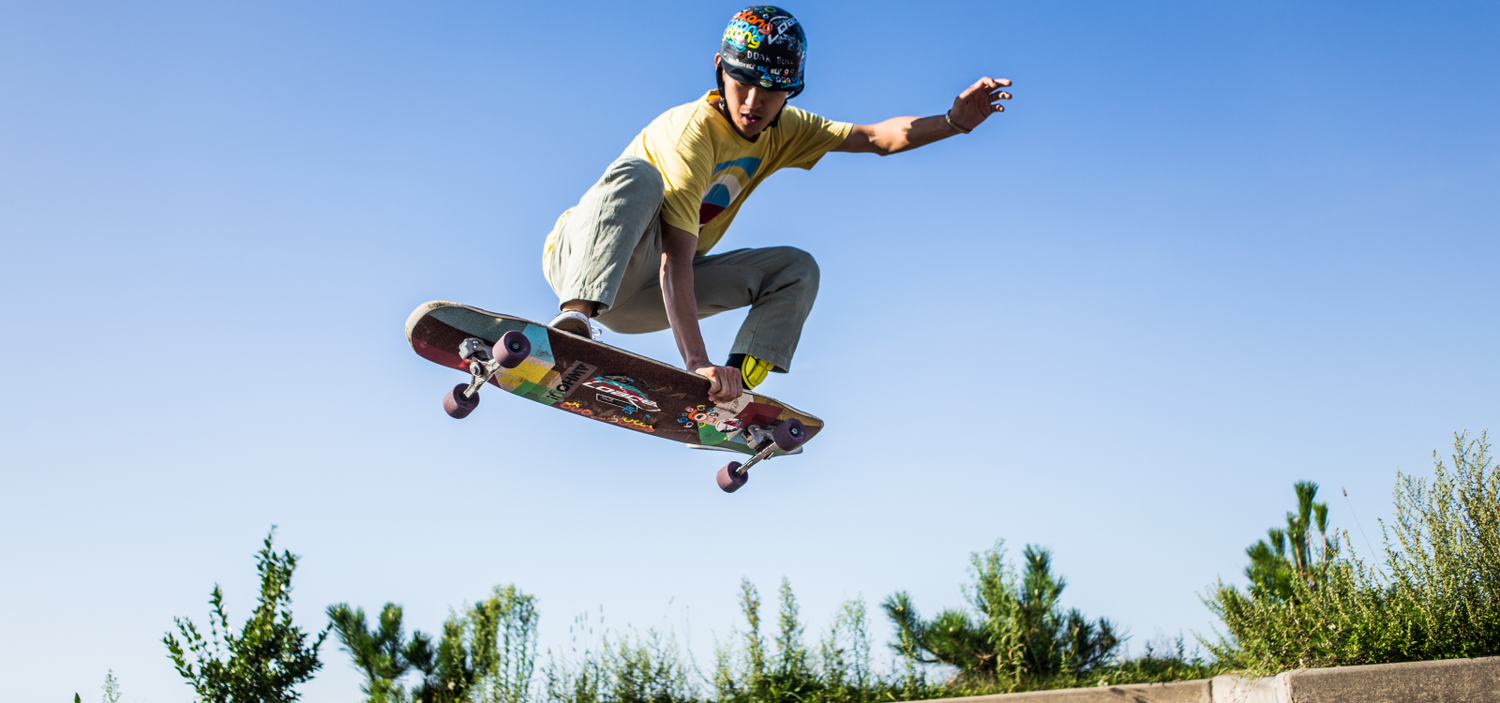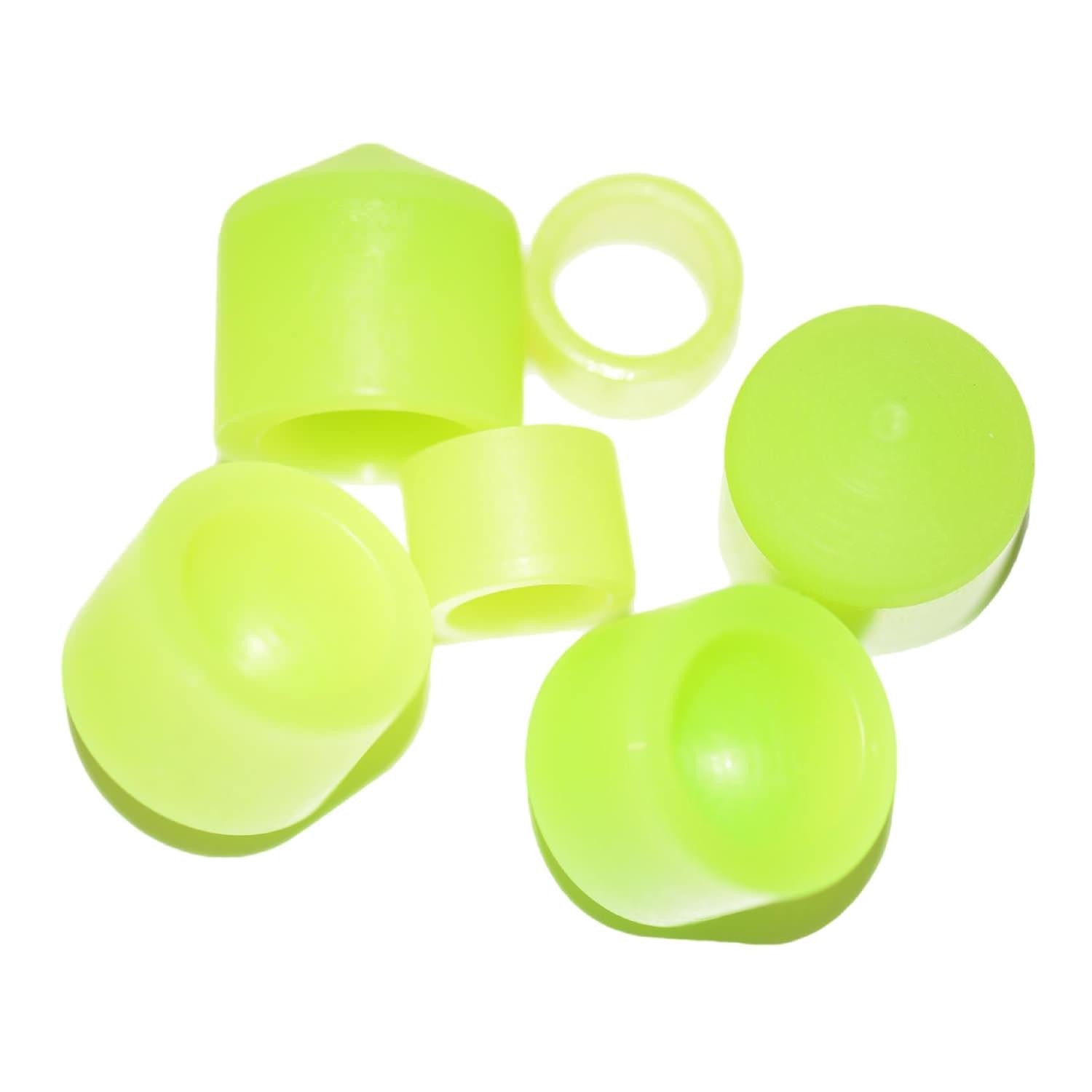-
👑
Downhill
Caliber Truck Co. -

- Why it's rad: Caliber bushing seats are a home run for downhill stability.
- Buy at Stoked Buy at Amazon
-
🏆
Overall
Paris Truck Co. -

- Why it's rad: Paris makes some of the finest trucks in the industry.
- Buy at Stoked Buy at Amazon
-
🤙🏼
Runner Up
Bear Grizzly -

- Why it's rad: Made famous for hanger flipping, Grizzly is the truck of choice for Landyachtz
- Buy at Stoked Buy at Amazon
Anyone who has even ridden a skateboard knows how important trucks are. Trucks hold the wheels to the deck and allow riders to turn. No skateboard (regardless how long or short it is) is complete without a set of trucks. But don't just toss any pair on a board! There are many distinct features that vary from truck to truck; each of which will change the skateboard ride drastically.
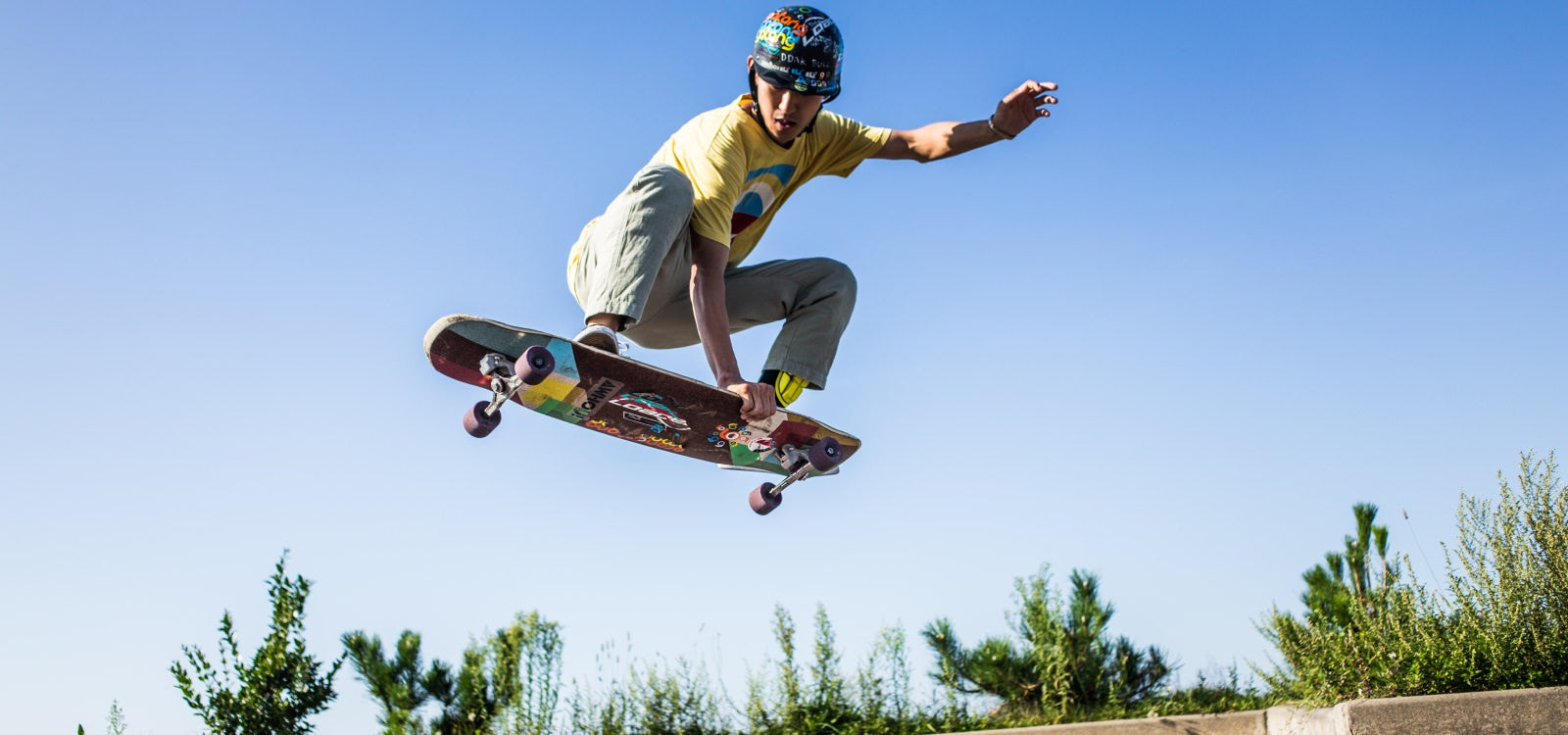
In this article, we go through each feature in great detail so as a buyer you can make the best possible decision for your shred sled. Let's get started.
Overview
Take a look at the diagram below for an overview of the parts of the truck. These are the most common parts that will come on every truck, regardless of other design or product choices. Please refer back if you're not quite sure about anything is mentioned in this article.
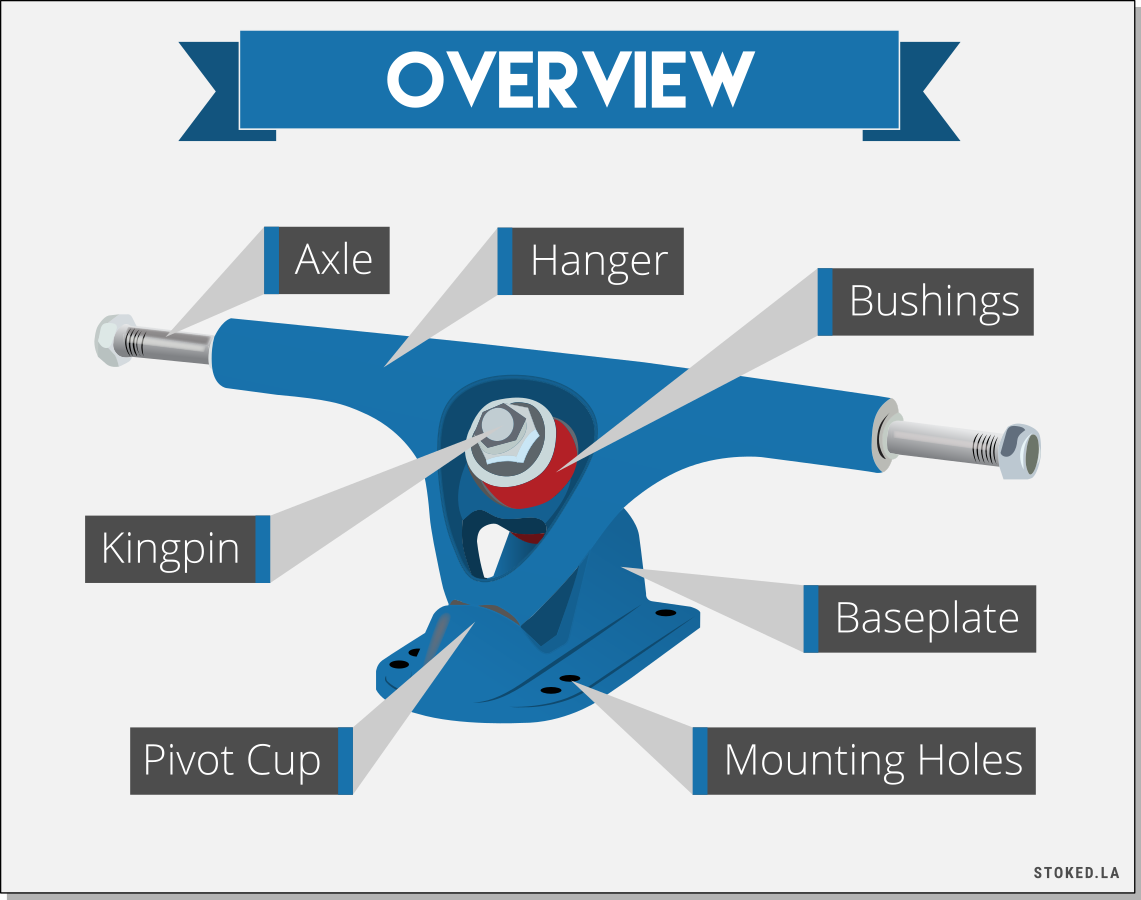
- Axle
- The part of the truck that holds the wheels and bearings. Axles can be 8mm or 10mm.
- Hanger
- The part of the truck that does the turning. The hanger can rotate because it is suspended on the baseplate using bushings and a pivot cup.
- Bushings
- Small urethane grommets that center the hanger and provide resistance when the truck is turned. There are two per side of the hanger: top (roadside) and bottom (boardside).
- Kingpin
- The largest bolt on the truck that holds the bushings and washers tight on the hanger.
- Baseplate
- Bottom truck mounting plate that locks the truck assembly to the skateboard deck. Baseplates come in various angles to change the turning geometry.
- Pivot Cup
- The small round bushing that the hanger rotates inside of. It also controls some of the feel of the hanger turn.
- Mounting Holes
- The holes in the baseplate where the hardware is placed to mount the baseplate to the deck. Comes in new school and old school patterns.
Features of Trucks
There are ten (10) qualities of a truck that will determine the overall feel. Each one of these qualities can be either chosen when the truck is purchased or modified later for changes in performance. Please feel free to click any of the titles to skip ahead to that category.
- Kingpin Placement
- There are two main types: Reverse Kingpin Truck (RKP) and Traditional Kingpin Truck (TKP).
- Hanger Width
- The width of each truck hanger (in inches or millimeters, typically ranging from 90mm to 215mm). This determines how wide the wheels track. The most common on longboards is 150mm - 180mm.
- Baseplate Angle
- The angle the hanger makes with the pivot cup. This is measured in degrees, usually ranging from 20° - 70° with 40° - 50° being the most common.
- Bushing Seat
- The area in the truck hanger where the bushing sits. The amount of room allowed for the bushings to compress varies from seat to seat. This plays a large role in the feel of the truck.
- Ride Height
- How high the truck stands the deck off the ground. This is measured from the center of the axle to the bottom of the baseplate. Most common for is around 2.3". Lower means more stability. Higher means more carve potential.
- Construction
- There are three main types: cast, forged, and precision. Cast is the most inexpensive, but the most imprecise and weakest. Precision is stronger than cast and offers extremely exact tolerances on bushing seats and bearing facings. Forged is the strongest of all three and offers a moderate level of precision.
- Pivot Point
- The type of pivot used in the truck hanger. There are three types: standard, cylinder, and ball. This determines how easily the hanger rotates during a turn, all else equal.
- Rake
- The amount of axle offset from the center of hanger rotation, measured in millimeters (+ / -).
- Mounting Pattern
- The hole mounting pattern in the baseplate of the truck. The deck holes needs to match the truck holes in order to mount the trucks to the board. There are two kinds: Old School and New School.
- Axle Width
- Thickness of the axle, either 8mm or 10mm. 10mm is stronger, but heavier and with much fewer bearing choices. 8mm is much more common and widely considered the "best" option for almost every application.
There is no right or wrong answer when asking which is the best truck or truck design. There are riders around the world breaking boundaries with all styles of trucks. It is all about personal preference. However, each truck does have an intended purpose and it's important to understand what features are good for what applications.
Kingpin Placement
There are two main truck designs available: the Reverse Kingpin (RKP) and Traditional Kingpin (TKP). Each are good for distinct types of riding.
Reverse Kingpin (RKP)
Commonly referred to as the "longboard truck", RKP trucks are best for most longboard applications. The way the truck is designed allows for responsive turning while remaining stable and smooth, even at higher speeds. They do have a higher ride height than traditional kingpin trucks, so keep this in mind when building a set up. The extra height can be uncomfortable during grinds and flip tricks.
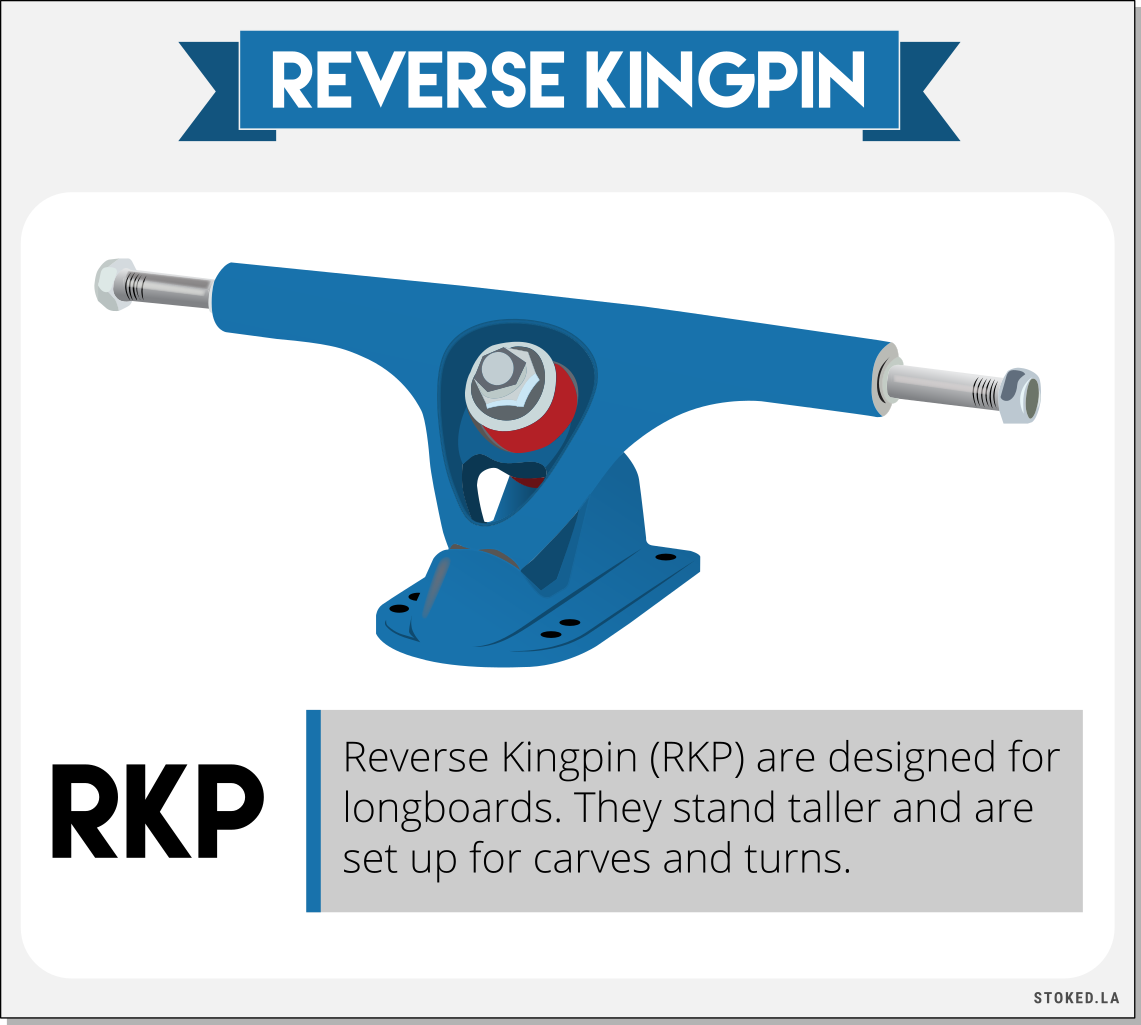
Due to the orientation of the kingpin in RKPs, grinding and slappies are usually not ideal on RKP style trucks, but can certainly still be done. Reverse kingpin trucks also tend to have more stock baseplate angles to choose from (read about baseplate angles). Reverse kingpin trucks turn much more predictably at speed, which makes them ideal for longboarding applications.
RKP Style Trucks:
It's worth noting that while longboard guys could ride TKPs, it would be incredibly rare to see a professional street skater riding RKPs. They are simply too tall and heavy to be practical in this setting.
Traditional Kingpin (TKP)
A traditional kingpin or old school style truck is designed primarily for trick skating. However, given the right set up, they can excel in freeride and downhill. TKPs generally have a much sooner release/less grip and much more progressive turn than RKPs. There are a few other things that set TKPs apart from their reverse kingpin cousin.

First off, the hanger is usually better suited for grinds, as there is more distance from the kingpin. TKPs also typically have a lower ride height, so riders can get better board rotation when doing tricks. In general, a TKP truck will have a “flatter” and more responsive turn where riders feel more on top of their trucks, but this also can create a bit more unwanted twitch at higher speeds.
TKP Style Trucks:
Again, it is all about personal preference and comfort on each style of trucks. There are some who prefer the feel of a TKP for downhill (plenty of OG downhill skaters swear by the Indy 215) despite the fact that RKP's are generally accepted as the superior downhill truck.
Hanger Width
The width of the hanger works exactly the way most people would imagine that they would. that a narrower truck (narrow being in the 150mm region) is a lot more nimble and maneuverable, as opposed to a wider truck (higher than 180mm).
The wider trucks offer more stability and are also geared towards higher speeds. Wider hangers are more ideal when trying to avoid wheel bite as they position the wheels slightly further from the deck. However, more width brings less grip. This is why skaters ride tiny hangers in slalom courses and races like Maryhill. Grip and turn are paramount, rather than stability.
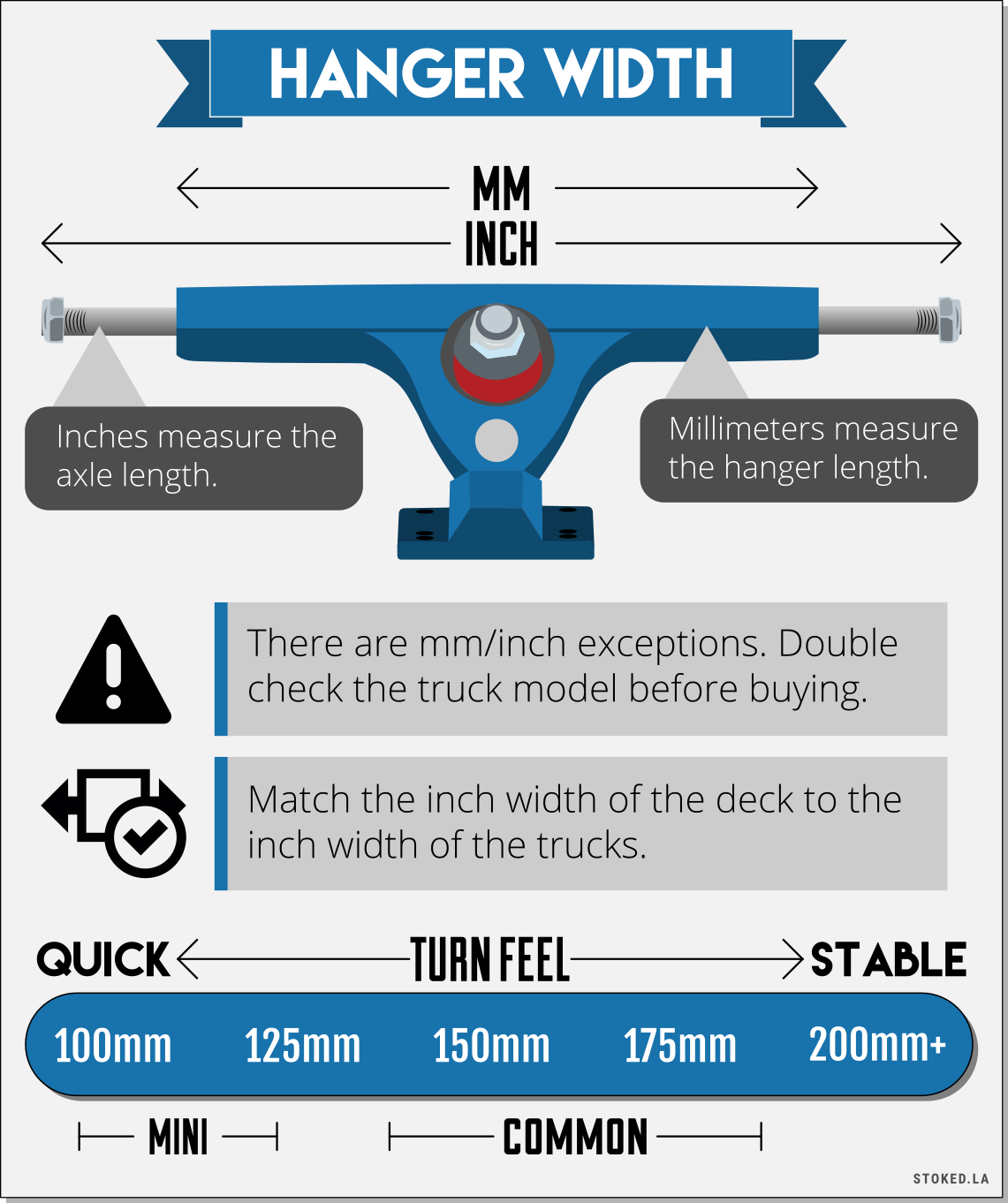
Truck width should be determined by the rider's style and the type of board. For longboards (36"-45" or 91cm - 114cm), the most common width for all around riding is the 180mm truck. It is capable of handling all kinds of riding, from downhill to cruising. The 180mm truck is rad because it offers stability while still being capable of cruising and carving. More nimble longboards are most commonly found with a 150mm truck.
Truck Conversion Chart
Below is a helpful conversion chart that we created. This will cover all of the trucks that we sell. Again, please note that mm does not convert directly to inches. This is because inches includes the axles while mm just includes the metal hanger portion.
To choose a truck, 9 times out of 10 you will (as closely as you can) match the skateboard deck width to the inch measure of the truck width.
| Millimeters (approx.) | Inches (approx.) |
|---|---|
| 85mm | 5.9 in |
| 100mm | 6.4 in |
| 109mm or 110mm | 6.8 - 6.9 in |
| 120mm | 7.2 in |
| 129mm or 130mm | 7.6 in - 7.75 in |
| 139mm or 140mm | 8.0 in |
| 144mm | 8.25 in |
| 149mm or 150mm | 8.5 in |
| 159mm or 160mm | 8.75 - 8.9 in |
| 165mm | 9.0 in |
| 169mm | 9.125 - 9.5 in |
| 180mm | 9.5 in |
| 190mm | 10.0 in |
| 215mm | 10.0+ in |
| 115mm | 4.3 Bennett = 6.8 in |
| 130mm | 5.0 Bennett = 7.5 in |
| 150mm | 6.0 Bennett = 8.2 in |
Baseplate Angle
The baseplate angle of the trucks can change the ride drastically. The top truck brands usually offer two variations of their truck, something around a 40 degree and 50 degree.
| Truck Brand | 40-ish Degree | 50-ish Degree |
|---|---|---|
| Atlas | 40 | 48 |
| Bear | 40 | 52 |
| Caliber | 44 | 50 |
| Paris | 43 | 50 |
| Randal | 42 | 50 |
The 40-ish degree baseplate excels in both freeride and downhill because it allows the rider to lean more with less turn. This gives the rider's deck good leverage over the wheels. This leverage without tons of turn provides a secure feeling when soaring down a hill. 40-ish degree trucks are most often found on high performance, fast freeride set ups.
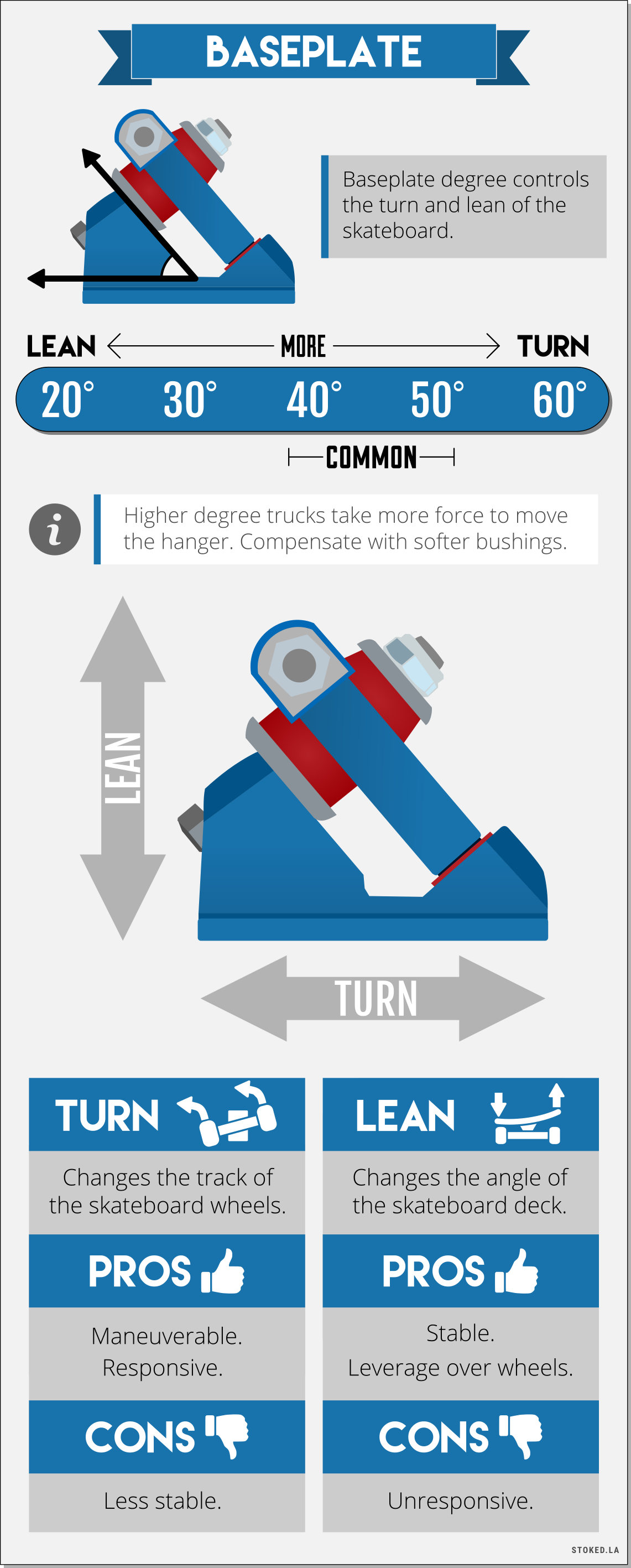
The 50-ish degree versions give riders more turn and less lean, making them feel more darty and responsive. But the 50s are also commonly taken to high speeds. In fact, many people prefer the feeling of turning into slides and are completely capable of taking 50 degree trucks fast. Another advantage with the 50 degree truck is that it is not only capable of being taken downhill, but also feels awesome when cruising, carving, dancing, and anything else in between.
Bushing Seat
The bushing seat of a truck is arguably the most important aspect, as it will greatly determine how the truck feels. There are 2 main types of bushing seats: restrictive, as in a PNL Truck and loosey goosey as in a Randal Truck.
There are all sorts of bushing seats out there, some are deep, some are shallow, some are chambered, some are sharp, some are tight, some are loose, some are stepped, some are flat, and some are round. With all these features, they can be broken down into three categories: Round, Flat, Stepped.
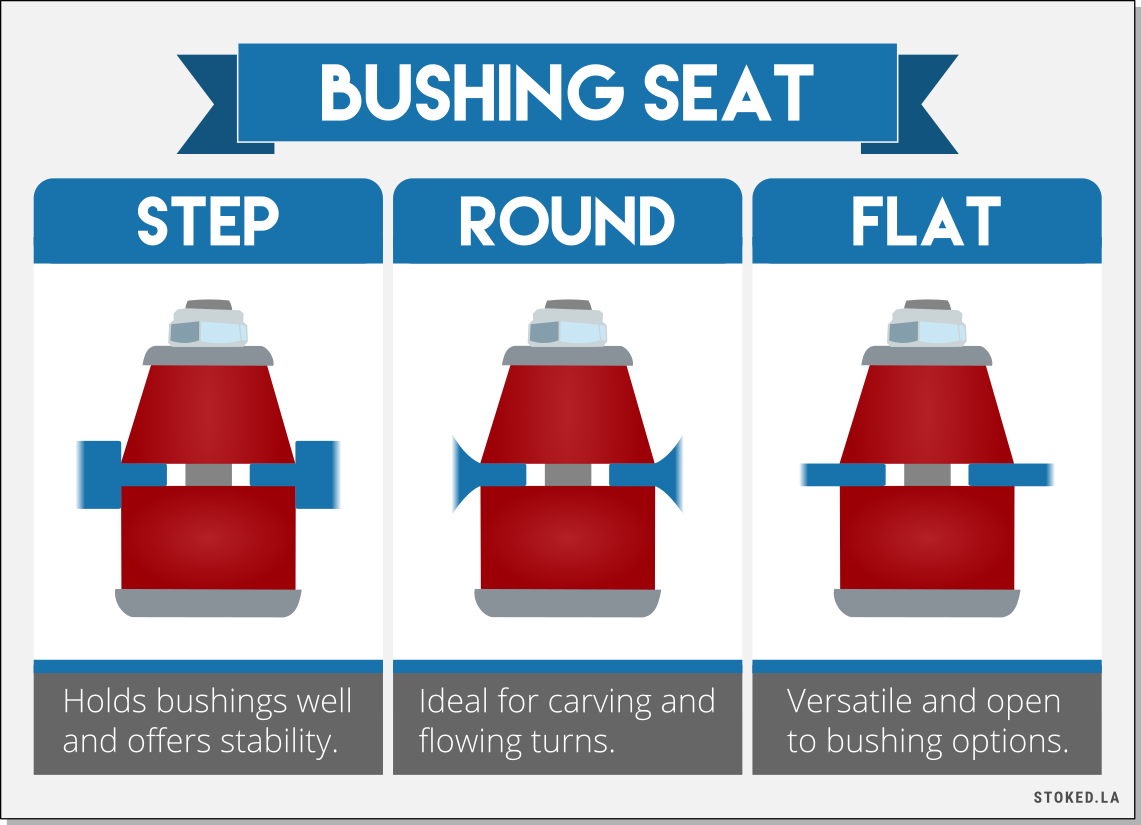
Round bushing seats allow the bushings to flex and flow throughout the truck, while still giving some rebound and centering. This gives a great carving feel. Some examples of trucks with round bushing seats are Paris and Bear Kodiak.
Conversely, a stepped bushing seat is one that is deep, sharp and tight. All of these features do not allow for much play when turning. This gives riders a much more defined center point which is ideal for downhill. A disadvantage to a really restrictive bushing seat is that regardless of what bushings are put into the truck, it may still feel restrictive or dead in that center spot. Trucks that have stepped bushing seats include Caliber IIs, Atlas, and Bear Grizzly.
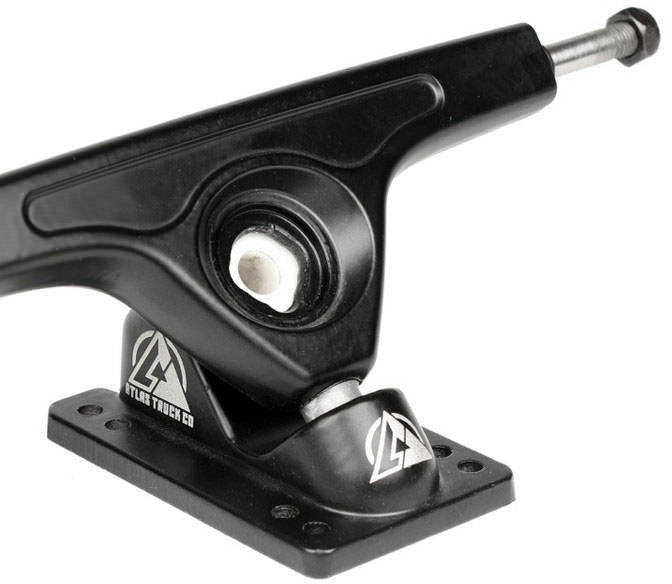
A flat bushing seat is the most basic and versatile out there. Flat means the hanger gives very little or no rebound to the bushings. This allows the greatest freedom in bushing shapes, but the least stability with speed. Flat bushing seats are best for LDP style boards and are famously found on Don't Trip Trucks.
Ride Height
Ride height is defined as the height of the truck from the bottom of the baseplate to the middle of the truck axle. Measuring from the middle of the truck axle gives the most true measurement for truck ride height across various board designs. However, actual riding height can change depending on the deck design (dropped deck, dropped through, etc).
The ride height of a skateboard truck changes many things. The most prominent is stability with speed. The lower the truck sits, the more stable it will be with speed.
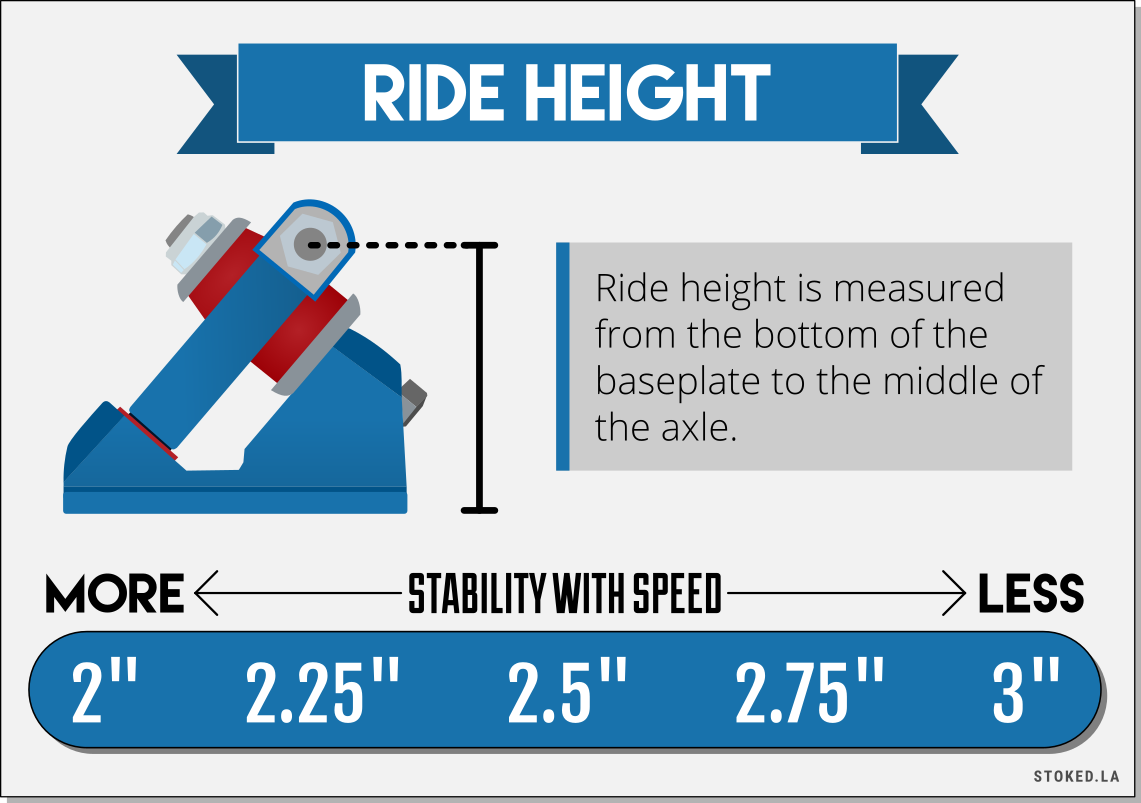
However, this is not the only consideration when choosing which ride height is best for an application.
A higher setup gives:
- More “surfy” feeling with deeper turns
- Snappier hookup (wheels regain traction faster)
- Easier to fit larger wheels
- Can generally run trucks looser
- Less stability at speed
- Harder to push and footbrake
A lower ride height gives:
- More stability at speed
- Easier to push and footbrake
- More predictable and controllable slide
- Greater risk of wheelbite
- Generally trucks need to be run tighter
- Less turning “feel”
So why do lots of top downhill/freeride guys run top mount boards if they bring less stability with speed and a faster slide hook up? Simply because those top riders can handle it. They've spent countless hours honing their skills so the advantages of top mounts are far outweigh the disadvantages. The quicker hook ups and increased turn is welcomed by the pros. Other boards can feel a bit dead. It truly is about the rider, not the set up. Skate within your limits and work your way up.
Truck Construction
Skateboard trucks are almost always made from metal. Metal is manipulated in many ways to create tools of shred. Let’s talk about the three most common forms of truck construction.

Cast Trucks
Cast trucks are what most people think of when they think of a skateboard truck. The majority of both longboard and skateboard trucks are made from cast aluminum. This means that the metal is poured into a pre-built mold, left to dry, and solidify.
Although the construction may not be the best, cast trucks simply work for 90-95% of riders out there. One does not need incredibly tight tolerances cruising around your neighborhood, pushing, or freeriding under 30mph. Even though those precision trucks do feel REALLY good, they aren’t strictly necessary.
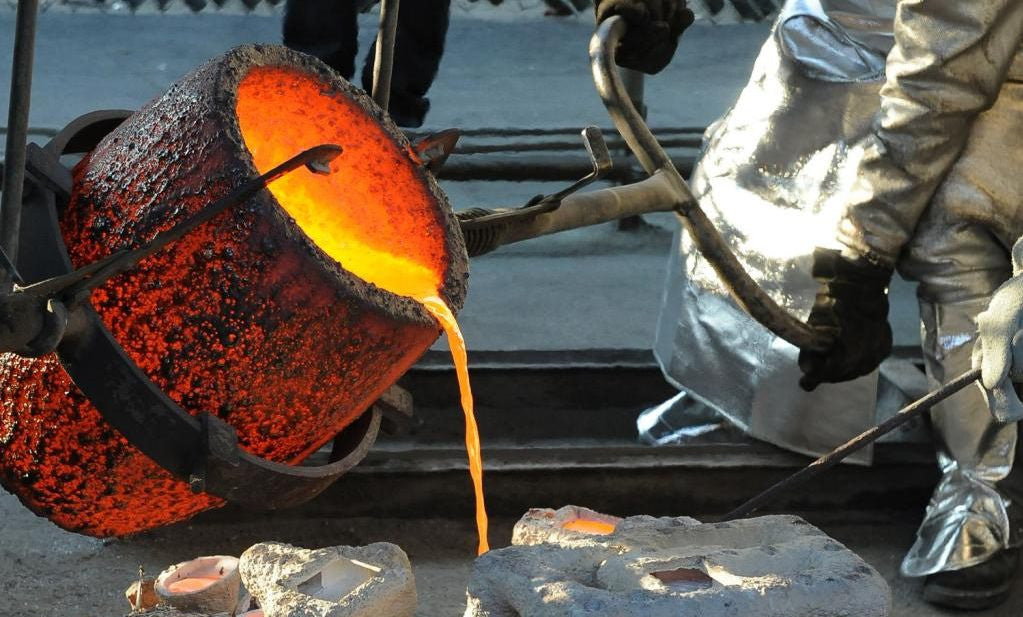
Strength - Cast trucks are, relative to the other types, the weakest type of trucks in term of durability. The grains of cast metal fall into random patterns when poured, which in turn creates weak points in the components of the truck. The “grain” of the aluminum is completely random. Case trucks have more imperfections and also can’t be manipulated as easily as precision trucks (this is why there are holes and crazy shapes in precision trucks, but not casts).
Cast trucks have also been known to bend under heavy freestyle, and from being taken off large drops. Heavier riders may also experience bending in cast trucks, simply due to the added force being put on them. Those experiencing bending in cast trucks may want to invest in forged or precision trucks to avoid further bending.
Price - Cast trucks are the most inexpensive of the lot as they are the easiest to produce. For the large majority of skateboarders, cast trucks will be sufficient for his or her riding needs. Given the large price difference between cast trucks, precision trucks, and forged trucks (read below), cast trucks simply make sense for the majority of riders.
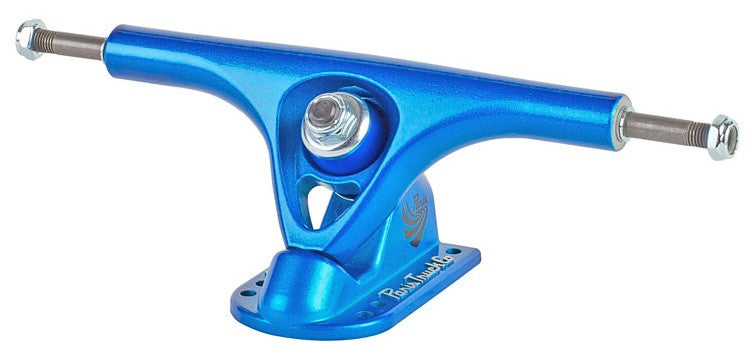
Bushing Seat - The bushing seat on cast trucks is usually fairly rough. It's hard to get metal to flow into 90 degree corners within the molds, and as a result, most cast trucks have rounded areas for the bushings to sit. Also, because cast metal is poured into a mold, there are always small imperfections throughout the truck.
Fit / Finish - Cast usually has the roughest fit and finish, but there are certainly brands out there that do a killer job with their cast designs.
CNC / Precision Trucks
Precision trucks are cut from a block of aluminum, stronger than that used in cast trucks, using a CNC machine. The CNC machine allows for much tighter tolerances and more precise shaping, which in turn creates less slop and play in the truck.
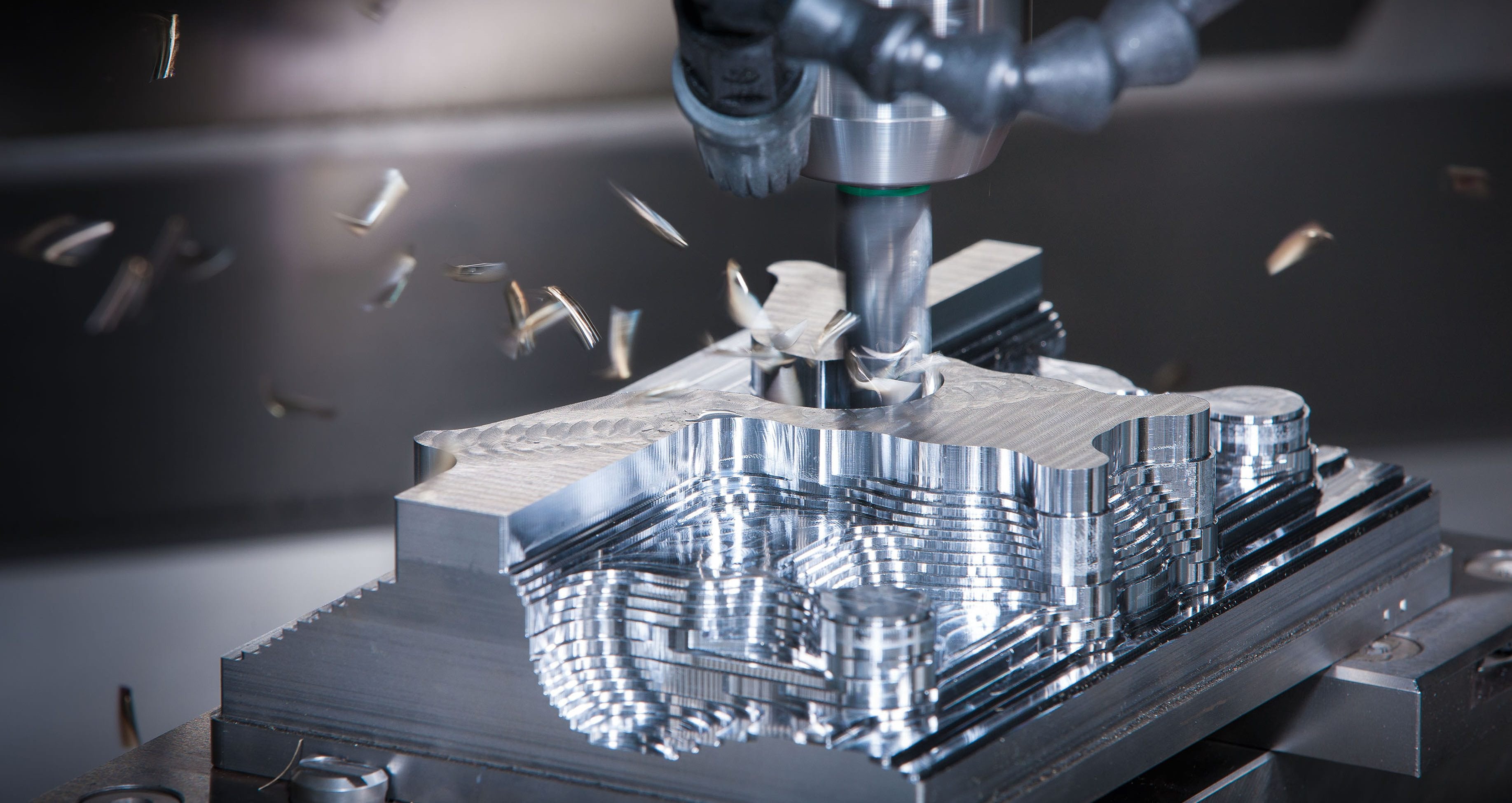
Strength - Precision trucks are very strong because the cutting goes in the same direction of the aluminum block it is being cut from. The "grain" of the metal is completely straight. The aluminum used to make precision trucks is also stronger than the cast metal used in cast trucks.
Price - CNC machining is extremely expensive. Not only is the cost of running a CNC machine expensive, but the aluminum block used to create the truck is expensive as well. If that wasn't enough, there is usually a good amount of excess material left after a precision truck is machined, as a truck will never used up a full block of aluminum, due to their obscure shape. All of these factors lead to CNC trucks being the most expensive to purchase, simply because the cost of manufacturing is also very high.

Bushing Seat - The bushing seat on precision trucks is as perfect as they come. Because the seat is cut using CNC, the seat has super tight tolerances that allow for the least amount of slop. Riders may even experience some difficulties getting some bushings into precision bushing seats, as bushings are rarely cut to precise tolerances, and may be slightly too large for a bushing seat with an exact tolerance.
Fit / Finish - Simply put: Precision trucks are beautiful. They're elegant and immaculate. This is what is so appealing about precision. Bearings, bushings, and hardware all works flawlessly with them because of their CNC'd perfection.
Forged Trucks
Forged trucks take that same block of aluminum used in precision trucks, but rather than cutting it; it is beaten (forged) into the desired shape. Occasionally, manufacturers will forge trucks, but CNC some of the smaller components in order to create a more precise product.
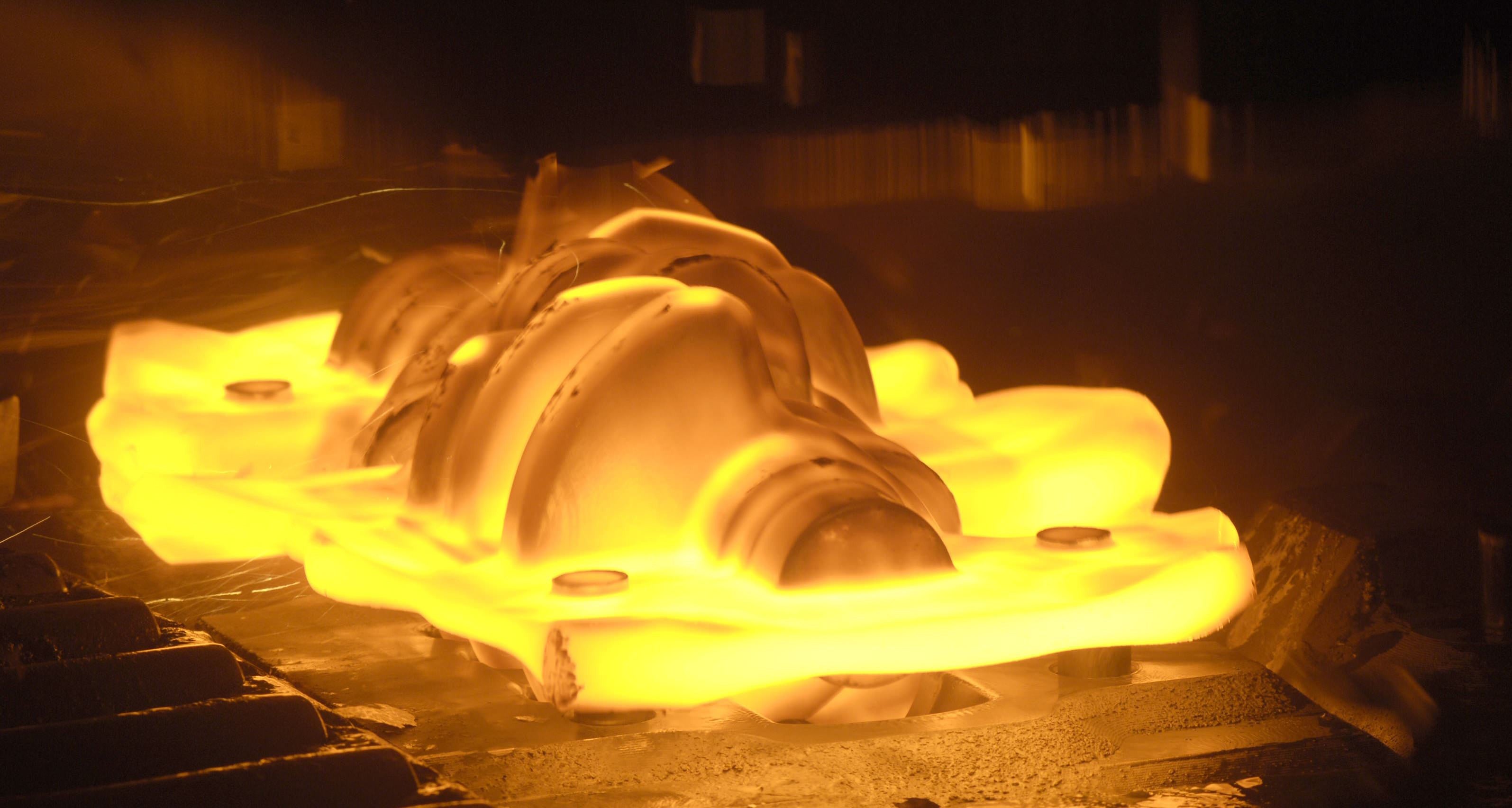
Strength - Forged trucks are actually the strongest trucks available on the market today. Forging perfectly aligns the grain structure with the shape of the finished truck. However, because forged trucks are not cut completely on a CNC machine, slight imperfections may be present in the truck. Along with this, the forging process requires beating the metal, which in turn creates a dense material that is relatively heavy.
Price - Forged trucks usually cost more than cast trucks, but less than precision trucks. This is because the cost of manufacturing them is not as expensive as using a CNC machine to cut precision trucks, but more than the cost of pouring cast trucks.
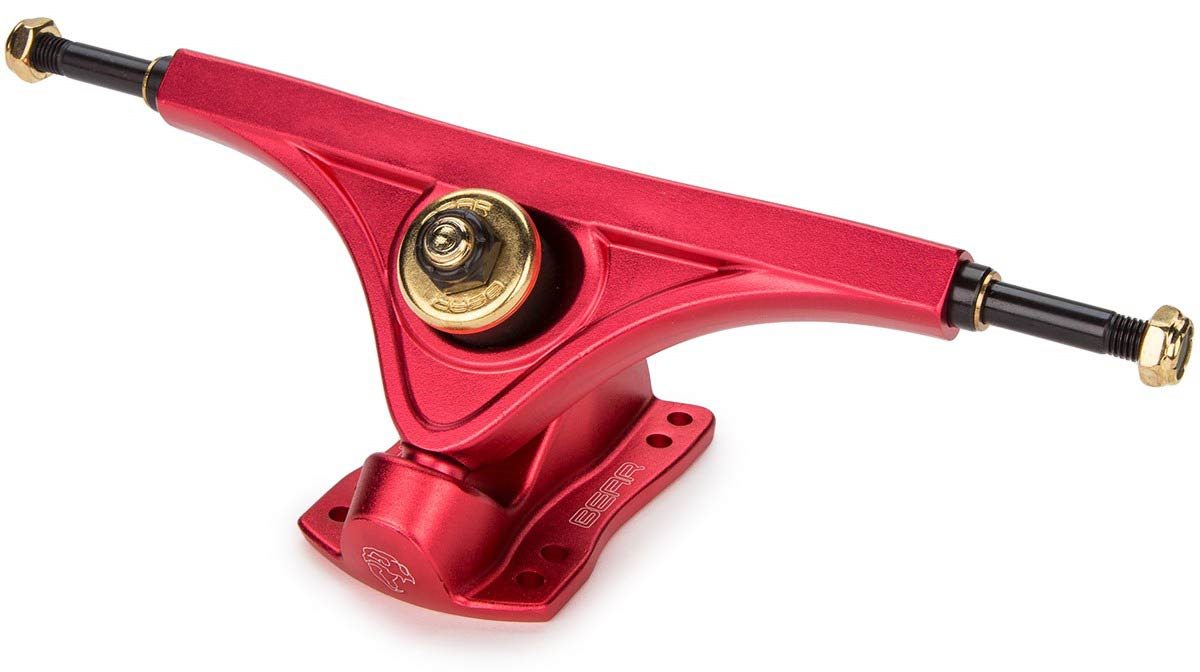
Bushing Seat - The bushing seat on forged trucks is better than cast, but not quite as good as precision. Usually forged trucks also have an additional machining process in order to make the bushing seats as precise as on precision trucks.
Fit / Finish - Forged is better than most cast when it comes to finish, but they certainly are not as perfect as precision. Lots of companies will machine the bushing seats and hangers to get the accuracy of precision trucks with the strength of forged.
Pivot Point
Pivot cups are where the truck's pivot sits in the baseplate. The main types are a standard pivot, cylindrical pivot, and a more circular ball pivot. The cylindrical pivot is the most common of the bunch. Ball pivots provide more responsive turning, but can also be slightly twitchier at higher speeds. Once again though, it's all about personal preference, as some of the best trucks on the market such as PNLs make a stable, rad, downhill-oriented truck using a ball pivot.
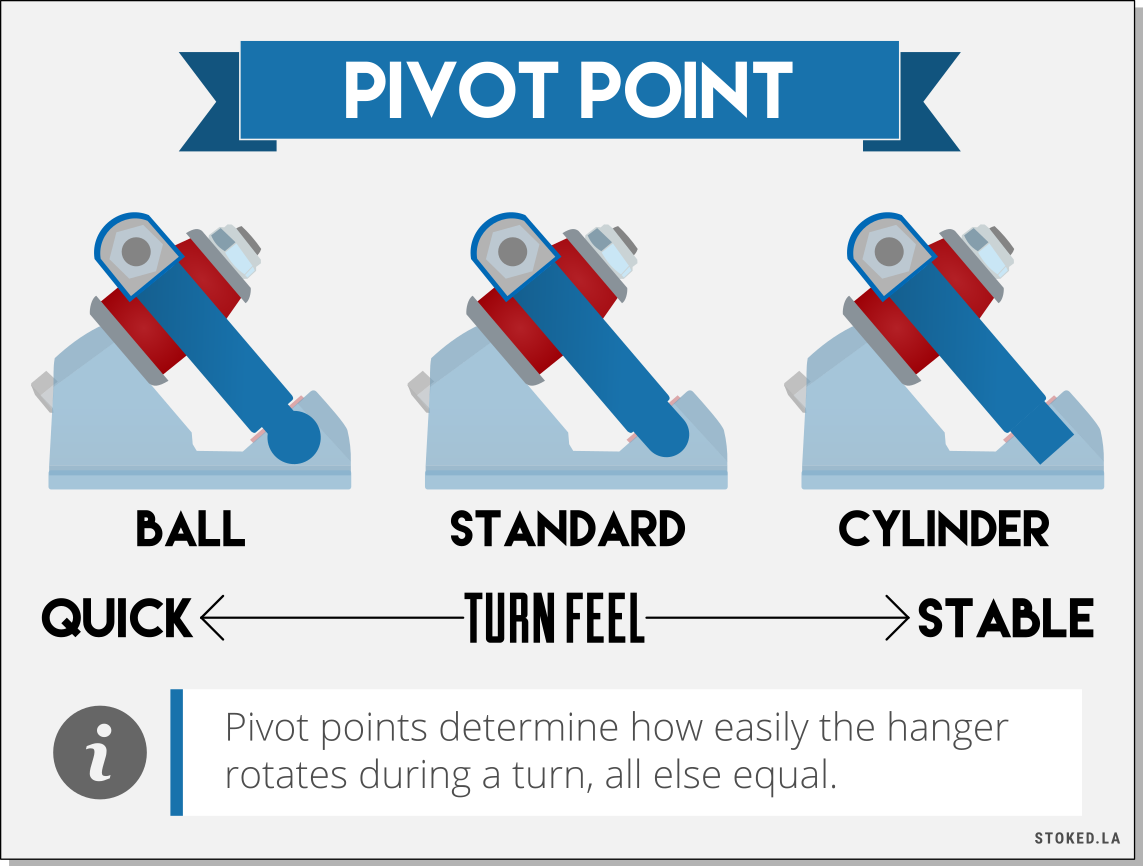
The actual pivot cup is a thin piece of urethane that surrounds the pivot. Most trucks come with stock pivot cups that work decently, but wear out quickly. Recently however, more and more companies are making high quality urethane pivot cups available in different durometers. The softer the cup the more smoothly the truck will turn, but the more responsiveness will be taken away. In general, 95a and above are suitable for downhill and freeride. While pivots may not seem that important, one might be surprised by how much they can change the feel of a truck.
Rake
Rake is one of the hardest truck features to understand. It affects the ratio between turn and lean. It is defined as the amount of axle offset from the center of hanger rotation, measured in millimeters (+ / -).
It is important to note that rake is NOT changing the rotation of the hanger (aka the baseplate degree of the truck). It only changes the location of the wheels relative to the axis of rotation. This controls how much the truck dives into a turn and how much the truck resists lean. The amount of rake can be measured in millimeters from the axis of rotation. Rake that is measured in baseplate degree changes is not accurate. Again, rake does NOT change the hanger axis of rotation.

Positive Rake will...
- Create a fast, then moderate turn
- Increase the ride height
- Raise the center of roll
- Have strong return to center
Zero Rake will...
- Have a linear turn
- Have a normal ride height
- Have a centered center of roll
- Have no return to center
Negative Rake will...
- Create a moderate, then progressively faster turn
- Decrease the ride height
- Lower the center of roll
- Have weak return to center
Rake vs. no rake is all about personal preference, so try out each to find what works best.
While not exactly rake, one last point that is worth mentioning is the position of the kingpin hole relative to the axle. Manufacturers position this in one spot up, down, or centered on the hanger, either closer to the pivot cup or closer to the axle. Closer to the pivot makes the truck more responsive and twitchy. Closer to the axle makes the truck more stable. This has to do with the amount of leverage over the bushings from the hanger. Notable twitchy example: Bennett. Notable stable example: Caliber.
Mounting Patterns
The mounting style refers to the holes in the trucks and on the board, through which the trucks mount to the board. It’s always a good idea to check the type of mounting on a set of trucks and a deck, as they may or may not be compatible. Old school holes are further apart (64mm) and new school holes are closer together (54mm).
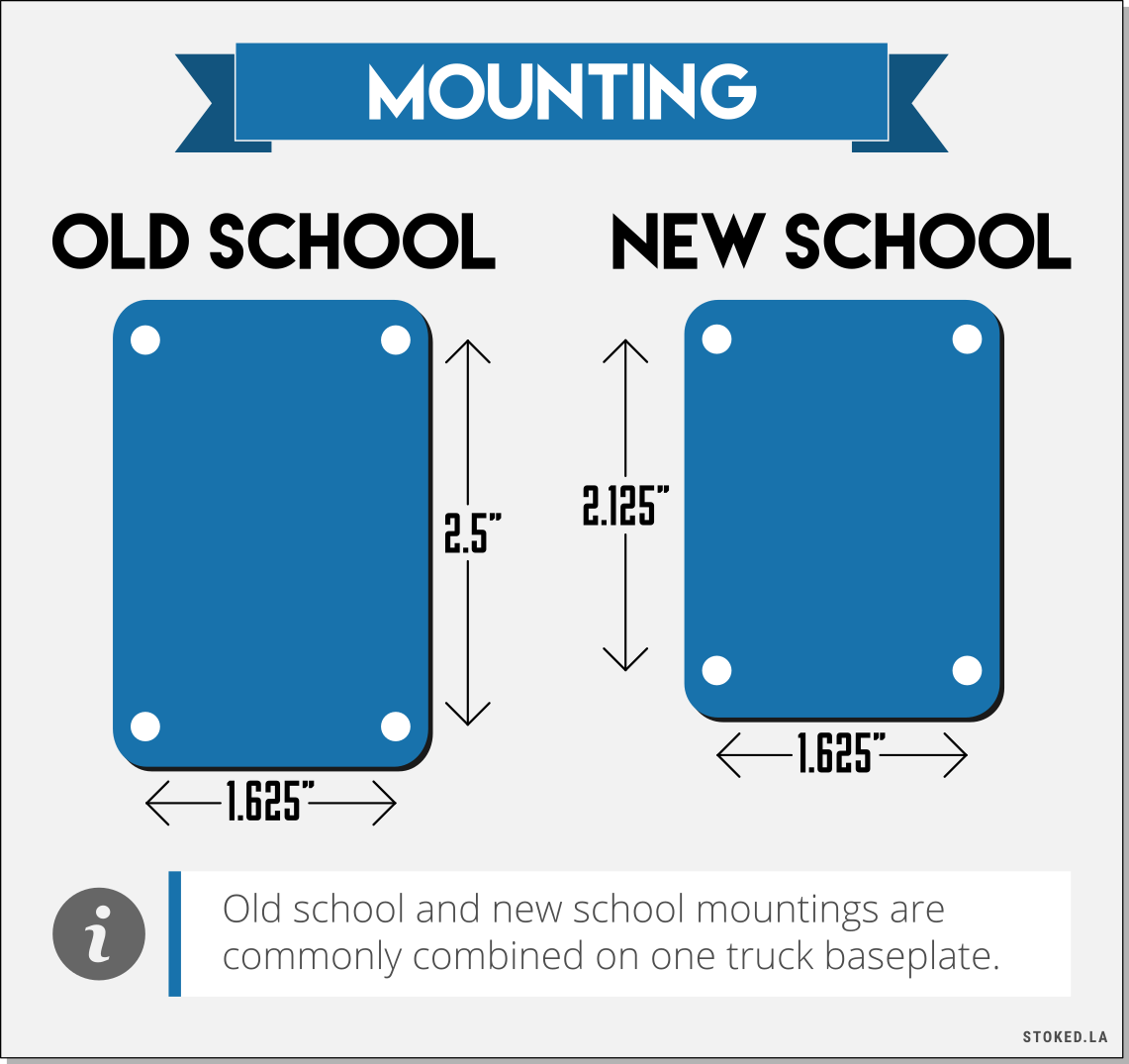
New school holes came about through pool skating to prevent hardware hangups, and while theoretically old school holes might be slightly more stable, the difference is very small. The good news is, nowadays most trucks and boards come with both new school and old school holes drilled into them, so riders can choose whichever they prefer.
Axle Width
Changes in axle widths are now pretty uncommon, but they are worth mentioning. There are two: 8mm and 10mm. The 10mm took off around 2009-2011 when there were concerns with axles bending.
These concerns have been addressed with better truck designs and stronger casts. 10mm required different bearings that were only offered from a few brands. Lack of bearing choices and extra weight that comes with a 10mm axle has caused this version of truck to almost become extinct.
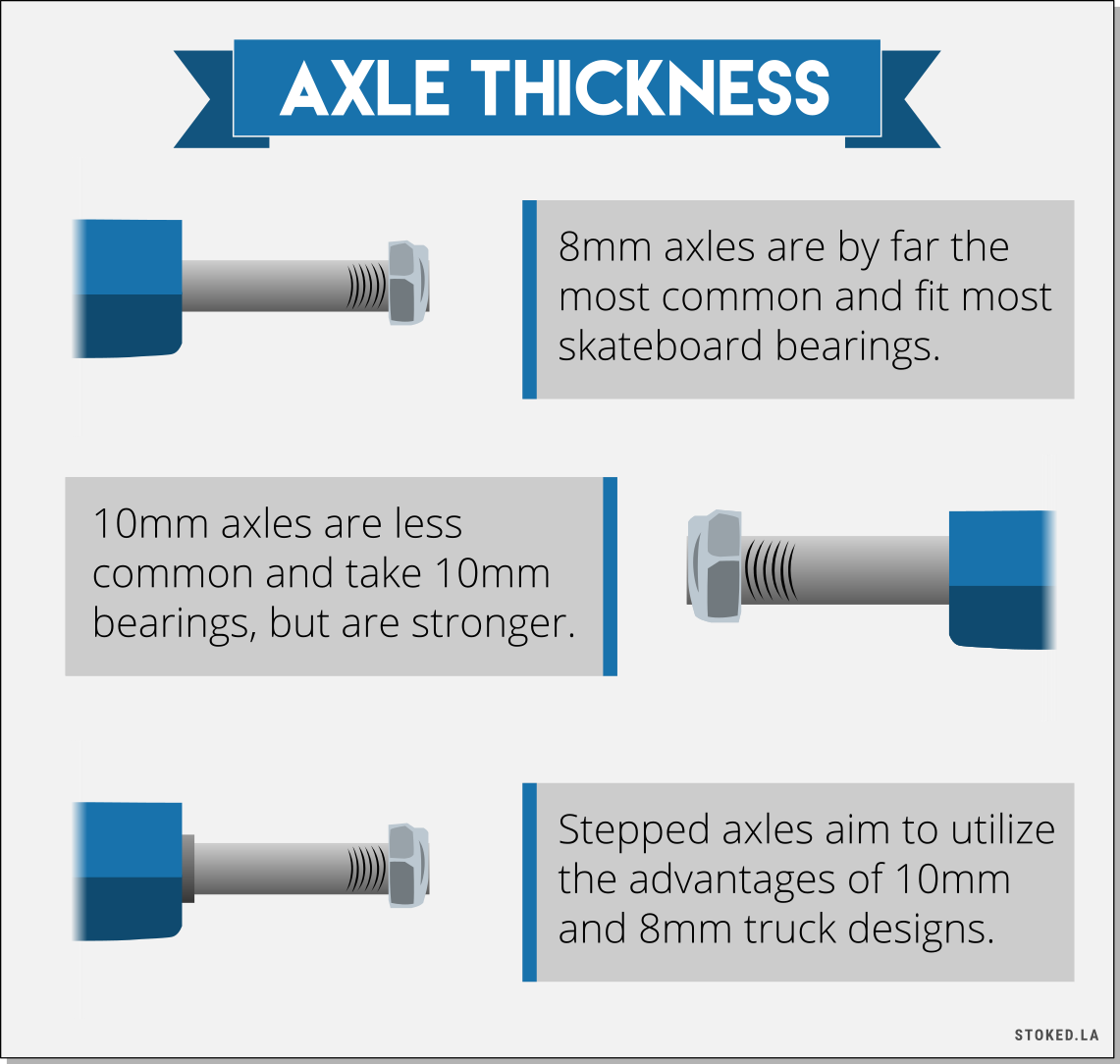
However, there are some brands out there (Atlas Trucks most notably) that are doing 10mm axles through the hanger with 8mm axles for the wheels. The idea is to keep a strong hanger, but still allow riders to use all types of bearings.

Conclusion
If this article taught nothing else, it's that there are a ton of different aspects of a truck. Each will give it different ride characteristics and performance changes. With so much variety out there, it all comes down to personal preference. We encourage all riders to try out different models to see what works best for their particular ride style.
Want to learn more about trucks? Also be sure to see our article on Turn vs. Lean for how to choose a baseplate degree.
Frequently Asked Questions
Mount the trucks so that the pivot cups always face away from the center of the skateboard deck. The front truck pivot cup points towards the nose and rear truck pivot cup points towards the tail. This is true for both traditional kingpin (skateboard trucks) and reverse kingpin (longboard trucks).
If you do not know what a pivot cup is, read about pivots here.
Longboard trucks use a kingpin bolt just like traditional skateboard trucks. You can use a normal skate tool to tighten or loosen the nut on the kingpin bolt to get less/more turn.
Be careful not to over loosen your trucks. The nylon locking ring in the kingpin nut should always be fully threaded on the kingpin.
Additionally, be careful not to over tighten your trucks. The bushings can be smashed and damaged. If your longboard trucks are too loose, we recommend getting harder durometer bushings.
Yes, you can! This can make for a very fun skateboard. Just make sure you still match hanger width to deck width and check for wheelbite before riding.
While some brands are subjectively better than others, there is not a "best" longboard truck. It depends on your application.
We like to compare it to cars. You wouldn't use a Formula 1 car to go off-roading and you wouldn't try to win F1 in an off-road car. Both cars are great, but only in their specific discipline.
Skateboards are the same way. Different trucks are going to be better for different things. Figure out what kind of riding you want to do and which board you are going to use. From there, we can offer recommendations about the "best" truck for your application.
While some brands are subjectively better than others, there is not a "best" longboard truck for downhill skateboarding. It depends on your application.
That being said, there are some clear winners in the type of truck to be used for downhill skateboarding. These are:
- Reverse Kingpin Trucks - This design gives more control and stability over Tradtional Kingpin Trucks.
- Bushing Seat - Sharper, precisely cut bushing seats are better than rounded, loose bushing seats. You want those bushings to stick in place at high speeds.
It will also help to have double barrel bushings on each truck, meaning a barrel bushing on the top (roadside) and bottom (boardside) of the hanger.
Double barrel bushings will improve stability since there is more urethane to support the truck hanger and rebound when turning.
It's common to hear about harder bushings for downhill and that is true to a point. However, you still have to turn when going downhill.
Learn more about speed wobbles.
Recommendations for Downhill Trucks
-
👑
Downhill
Caliber Truck Co. -

- Rad for DH: Caliber Trucks are precisely made and have sharper bushing seats downhill stability.
- Buy at Stoked Buy at Amazon
-
🏆
Overall
Paris Truck Co. -

- Best all around: Paris are precisely built and best for DH and all around riding.
- Buy at Stoked Buy at Amazon
Questions, comments, concerns? Hit us up at help@stokedrideshop.com We want to hear what you have to say!






